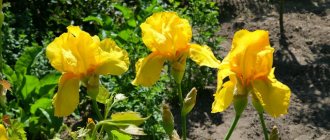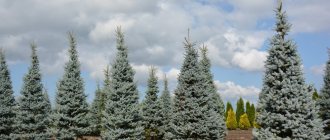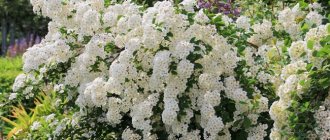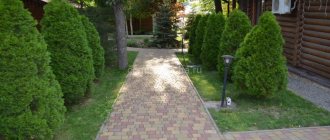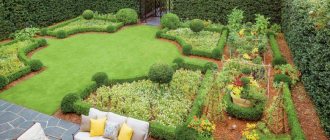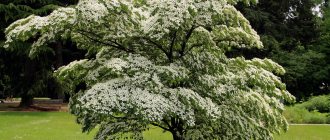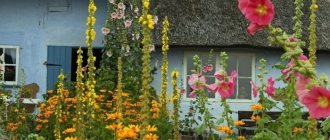Doren is a perennial shrub, whose decorativeness and varietal diversity amazes with its beauty all year round. The spectacular plant is easy to care for, and its planting is not particularly difficult. In landscape design, its use is varied, for which it is valued by gardeners. At any time of the year, a plant arrangement or hedge in different styles will decorate your garden plot.
Derain is an ornamental plant that is rapidly gaining popularity among owners of private houses and cottages.
Reasons to use turf in landscape design
The plant is quite in demand in landscape design. Its crown allows you to form various shapes and forms, and the contrasting color of the bark looks interesting against the background of fallen leaves and fallen snow. In addition, the perennial bush combines harmoniously with other foliage plants, which allows designers to create unusual compositions.
It looks very impressive, which is why the plant is often used in landscape design.
The turf shrub transforms the site not only in the warm season, but also in the cold season. In spring, the plant enlivens the garden landscape with budding leaves and blossoms, in summer with beautiful and dense foliage, and in autumn and winter it flaunts bright shoots.
The shrub is attractive both in summer and winter, and besides this, it is unpretentious and resistant to the most difficult climatic conditions.
In the design of local areas, turf is used in different ways. If the plot or garden is visible from all sides, then a high, dense hedge will provide good protection from gusts of wind and prying eyes. A distinctive feature of the shrub is its rapid growth and good branching. Therefore, a hedge is formed in a short time through frequent haircuts.
Variegated dogwood is one of the most striking achievements of breeders; this plant does not grow in the natural environment.
Decorative varieties are used to decorate the garden. Almost all types of plants are unpretentious. Doren tolerates moist soil well, so it is often planted near ponds and reservoirs.
The crop is also used to decorate the undergrowth, since its variegated forms highlight tall plantings well. In this case, a group planting scheme is used. Flowering species are relevant in tapeworm plantings.
The species was obtained on the basis of the white dogwood from the dogwood order.
For garden design, a chic ornamental shrub is a real find. It is popular not only in the design of garden and park areas. Doren tolerates urban conditions well, which is why roadsides are often decorated with it. You can appreciate the beauty of the design of the tree shrubs from the photo.
For reference! The dense growth and roots of the plant perfectly strengthen the soil, protecting the soil from erosion.
Planting wood for hedges
Sometimes you want to change something dramatically on your suburban area - this could be a new building or painting of buildings, but the most effective thing is to create an unusual hedge, which is called a living hedge. Today, the popularity of such fencing increases with each new season, since it is a new, unusual and stylish frame.
The most popular type of plant for creating a hedge is turf. The main reason for the high interest is the ability to withstand severe frosts and temperature changes in the soil, which are typical for our climatic zone, since the plant’s homeland is Siberia, meanwhile, green hedges made of derain can be seen in the gardens of Japan and China. A modern hedge made of derain is shown in the photo:
A hedge - derain - is the beauty, tenderness and tranquility of its owners, since this plant is very resistant to negative environmental factors. It is important to note that it is easy to care for and retains its attractive appearance for a long period. The fence of the site looks something like this:
A hedge made of white wood looks not only attractive, but also rich; it gives solidity and indicates the status of the person living in the house. It can be used to decorate hedges and fences on any type of soil - this is another plus of the plant.
Particularly popular is the Elegantissima hedge, which is a deciduous shrub whose leaves are attractively colored – light silver and green.
Description and photos of popular varieties of dogwood
A representative of the dogwood family, there are about 30 species and varieties, each of which differs in the size and color of the foliage. Miniature varieties reach a height of no more than 20-30 cm, other bushes or trees grow up to 1-3 m. Depending on the variety, the color ranges from white to red-pink. The calling card of many decorative forms is bright fruits. They are berries with juicy pulp and one or two seeds.
The shape of the leaves is heart-shaped, the edge is smooth, the main vein is clearly defined.
Let's look at the description and photo of popular varieties of wood in landscape design:
- Variegated dogwood. The bush or tree reaches a height of 3 m, has a large number of straight branches. Distinctive features of the plant are coral-red branches with brightly colored foliage. Leaves with a white or yellow border along the edges reach a large size. The inflorescence is white, reaches a diameter of up to 6 cm. Suitable for creating a living fence or decorating an alley and garden.
The plant is absolutely undemanding in care; the crop can adapt to almost any living conditions.
- Derain is offspring. The shrub, up to 1.8-2.8 m high, has a powerful root system and developed shoots. The crown diameter reaches 2-3.5 m. The peculiarity of this species is its numerous root suckers. The shoots are flexible, with shiny bark of different colors (from light green to red-brown or yellow). The buds are collected in corymbose inflorescences. The petals are small, white or cream in color. At the end of summer, white or lilac-blue inedible berries ripen on the derain bush.
A distinctive feature of the tree is its increased growth rate, as well as the ability to tolerate any pruning, even radial, without any damage.
- Deren Ivory Halo. A spectacular variety with strong vertical shoots of red-brown or coral color. The oval-shaped leaves are white-green in color with extensive light spots. In autumn they acquire a reddish-brown hue. A fast-growing shrub grows up to 2 m and blooms with yellow flowers. Suitable for group plantings.
A low-growing plant, it does not grow more than 1.5 m, the crown is spherical, and takes the desired shape even in the absence of pruning.
- White dogwood Elegantissima. The appearance of the leaf plate has a light edging, the flowers are painted white. The height of an adult plant is 2.5-3 m. The bush has a spreading form and quickly grows in all directions. The foliage is dense, white or deep green. White Elegantissima dogwood is the most popular variety in landscape design.
This is one of the most common varieties of derain, which is often planted in single plantings.
- Derain Sibirica Variegata. The fast-growing variety is capable of growing to a height of up to 3 m. It is characterized by a wide spreading crown, the diameter of which is 1.5 m. The color of the bark is bright, bushes of a bright red hue are often found. The leaf shape is ovoid, slightly folded. The flowering period occurs at the end of May, beginning of June. Planted both singly and in groups.
This is a low-growing shrub that grows up to 1.5 m. The shoots are bright scarlet, almost bloody.
- Derain f.Sibirica (Form Siberian). A dense bush with green leaves grows up to 1.5 m. It has a large number of upward-pointing red thin shoots. The main advantage of the decorative variety is the rich color of the bark. It has good winter hardiness.
The leaves are elongated, light green with a creamy edge.
For reference! There are tall varieties, the height of which reaches 7-9 m.
Highlights
A living fence is a series of planted plants that, when they grow, create an impenetrable barrier. The most important requirement for crops is high foliage density so that the inner courtyard area is not visible from the street. Most plants grow so well that it becomes more difficult to overcome this obstacle if there is a high concrete fence. The advantages of this alternative:
In general, hedges are planted mainly in park areas. But even in cottages you can find them, and in our country this is not so common, but the fashion for naturalness is taking its toll. Derain is a crop that gardeners in the Russian Federation are especially fond of, and such a plant has incredible beauty that blooms all year round. In summer, its lush crown is covered with cream-colored flowers, and in autumn the foliage turns deep red. The main colors are pink and burgundy. In winter, the bushes are decorated with bright fruits that seem to burn against the backdrop of snow-white snow. In spring, juicy and young greenery will appear again, filling the space with freshness.
Rules and recommendations for propagation and care of turf
Requirements for planting and caring for turf are minimal. The frost-resistant plant can withstand cold winds and can tolerate a small layer of snow. Therefore, the shrub feels comfortable in northern latitudes.
It will be correct to plant turf in the spring, since in this case the plant will have the opportunity to grow over the summer and become stronger.
Reproduction
There are several methods of reproduction. Amateur gardeners use the simplest option - the formation of layering. To do this, place a twig in a place cleared of turf and pour a compost or earthen roll. The rooting site should be kept moist. After a year, the rooted shoot is cut off from the mother plant. The resulting seedling is transplanted to a permanent place in the third year in autumn or spring.
Cuttings are harvested at the very beginning of summer. Last year's branches, not young ones, should be used, always with dense wood.
Without additional treatments, turf grows well from seeds. Their germination rate is quite high - 70%. But most often the plant is propagated by cuttings or root shoots. The best period for cuttings is the end of the flowering stage. The cuttings are cut at an angle of 45° with 2-3 internodes below the leaf buds. It is advisable to remove the foliage. Then they are planted in universal soil. Typically, rooting takes 6 weeks.
With proper care, by autumn they will take root and in the spring such cuttings can already be moved into open ground.
Care
Once planted, young seedlings are sensitive to dry weather. In the absence of rain, watering is carried out every 2 days for the first month, after which it is reduced to 1 time per week.
Caring for the tree comes down to watering, fertilizing and crown formation.
Important! Decorative appearance and good growth of the crop are possible only with constant soil moisture.
In cold weather, the soil around the plantings is mulched with compost or peat. Pour mulch in the circle around the trunk, without touching the trunk and the base of the shoots.
The derain should be watered once a month, and about 15-20 liters should be poured under each plant.
Seasonal feeding is also included in the care of the tree. For active growth and flowering, the plant is fed with slow-acting mineral fertilizers in the form of granules or powder. Fertilizer is added in May or June - during the growing season. In the cold season, potassium supplements are used to provide resistance to low temperatures and diseases.
Intensive soil moisture is required only for young seedlings up to the third year of life.
Decorative pruning of shrubs
Pruning is an important stage for a plant. The procedure allows you to preserve the decorative properties of the varieties, maintain their compact shape and the required height. Pruning the tree depends on the style of the garden and the role of the shrubs in it. In large landscape gardens the plant looks harmonious in its natural form. In this case, regular formative and rejuvenating pruning of the bush is sufficient. To do this, 1/3 of the oldest shoots and branches are removed in the spring.
Twice a year, the bushes are watered with a solution of mineral preparations based on the proportion of 150 g per plant.
The formation of the bush begins 1-1.5 years after planting. The dogwood shrub tolerates regular pruning well, which allows you to experiment with the geometry of the plant. To form geometric trimmed figures, cubes, balls and hemispheres from the bush, at the beginning of spring, old bare branches are removed at a height of 10-15 cm from the surface of the ground. As a rule, they are at least 3 years old. Young flexible shoots are used to make the basis for giving the shrub the required volume. The shape of the bush is adjusted by trimming the tips of the shoots in spring and July-August.
Pruning is an important step in tree care. It is best to carry out these manipulations in early spring, optimally in March.
An interesting idea is to grow derain on a small tree trunk. To do this, one or more powerful young shoots are tied together or tied to a vertical support. They are shortened at a height of 50 cm; in the future, the shoots form a trunk. The remaining branches are cut off at the root. The crown is formed from the apical branches, which requires regular removal of growth on the ground and new shoots on the trunk.
Derain tolerates even the most severe frosts, but this applies exclusively to adult plants.
We continue the conversation started in the article “How to choose plants for a hedge”
So, we have decided what we are planting and why. Now it is important to understand how this should be done: in one, two or three rows; at what distance from each other?
The density of planting in a hedge depends on the size and biological characteristics of the selected seedlings, as well as on the effect you want to achieve from an adult hedge.
If trees or shrubs are already mature and large enough, planting holes are prepared for each plant separately . The size of the holes depends on the size and age of the seedlings. The holes should be such that the roots of the seedling do not reach the bottom and walls by 10-15 cm. The best shape for planting holes is square with steep walls.
It is advisable to plant smaller plants for hedges in trenches . The depth of such trenches, as a rule, is 50-60 cm. The width varies depending on the number of rows of plants and on which shrub is chosen to create the hedge: vigorous, medium-growing or low-growing.
On average, the width of the trenches can be as follows: for single-row fences - 50-70 cm, for double-row - 70-90 cm, for three-row - 100 cm.
Plants in trenches in a two-row planting are arranged in a checkerboard pattern, and in a three-row planting - in groups of fives. Below - see the diagram.
PLANTING SCHEME FOR A DOUBLE-ROW FENCE
PLANTING SCHEME FOR A THREE-ROW FENCE
More accurately, the distance between seedlings in rows for deciduous trees can be determined taking into account the height of the selected plants as follows:
- If a tall shrub is selected (narrow-leaved oleaster, buckthorn buckthorn, blood-red dogwood, prickly hawthorn, soft hawthorn, spur hawthorn, Tatarian maple, ginnala maple, common lilac and Hungarian lilac, shadberry), a single-row hedge planting is used. In this case, the trench is dug 60-80 cm wide, and the distance between seedlings is 1.0-2.0 meters. Plants are placed in the center of the trench.
- If a medium-sized shrub is selected (vesicle carp, prickly and splayed plum, caragana tree, white dogwood, Amur barberry, needle hips, oak-leaved spirea, crown mock orange, chokeberry, golden and alpine currants), the hedge can be made either single-row or double-row . When planting in a single row, the distance between plants is 0.5-0.8 meters, and when planting in two rows - 0.7-1.0 meters. The distance between rows is 0.4-0.6 meters.
- If a low-growing shrub is selected (cotoneaster brilliant, cotoneaster entire, multifloral cotoneaster, white snowberry, common barberry and Thunberg barberry, Daurian rosehip and wrinkled rosehip, Douglas spirea, middle and Japanese, shrubby cinquefoil), single-row, double-row and three-row hedge planting is possible. For single-row planting, the distance between plants is 0.4-0.5 m in a row, for two-row and three-row planting, the distance in a row is 0.25 - 0.4 meters, and between rows is 0.3-0.4 meters.
- When creating borders, dwarf varieties and forms of the following plants are used: spirea varieties “Little princess”, “Golden princess”, barberries: “Kobold”, “Atropurpurea nana”, “Aurea”, mock oranges: “Dwarf”, “Gnome”. They are planted in a hedge with a row spacing of 0.25-0.3 meters.
Of course, these are only approximate planting schemes, which must be adjusted for each type of plant, based on the characteristics of the future hedge. For example, for trimmed hedges of shrubs that are easy to trim (cotoneaster, caragana and shrubby caragana, golden and alpine currants, common barberry and Thunberg), the planting pattern can be compacted. 4 plants are planted per linear meter.
A special article is flowering hedges . In this case, the plants are planted in one row, without any compaction. To achieve the most spectacular and decorative flowering, plants need to be given enough living space for nutrition and development.
The following plants can be used to create flowering hedges.
- honeysuckle - Tatar, Korolkova, ordinary, golden;
- hydrangeas - paniculate and tree-like;
- lilac: Hungarian and ordinary;
- varietal mock oranges: “Air landing”, “Yunnat”, “Zoya Kosmodemyanskaya”, etc.;
- spirea: Van Gutta, gray, sharp-toothed, Douglas;
- viburnum: Gordovina and common;
- hawthorns: pinnately cut, blood red, Arnold, etc.;
- rose hips: wrinkled rose and its varieties, blue rose, etc.
Good thorny flowering hedges are obtained from the Sargent apple tree.
Plants for creating flowering hedges are planted every 1-2.5 meters.
Of course, all species intended for such hedges can be planted in a compacted pattern and form a clipped hedge. But then the bulk of the flowers and fruits will be lost, and those that remain will end up inside the crown and will not be visible. Therefore, it is recommended to plant such plants freely.
Now let's look at the features of creating fences from coniferous trees. Planting patterns here also depend on the species and on what kind of hedge is needed: free-growing or clipped.
For free-growing coniferous hedges you can use:
- common spruce, prickly spruce, Serbian spruce. The distance between plants is 2-2.5 meters, provided that fairly large plants are planted - 2 and 3 meters.
- western thuja varieties “Smaragd”, “Holmstrup”, “Columnare”. Thujas are planted every meter.
- red cedar. The distance between plants is 0.7 meters.
Trimmed coniferous hedges are planted as follows:
- prickly spruce and common spruce - at a distance of 0.8-1 meter in a row - both for single-row and double-row planting. Leave 0.5 meters between rows.
- Thuja western species and variety “Brabant” - the distance between plants in a row is 0.5-0.7 meters.
I would like to talk separately about creating linden fences , because linden is a native Russian tree. It was from this material that fences, alleys, berms, and borders were traditionally created in Russia.
Small-leaved linden is suitable for creating hedges, and its variety “Greenspire” is especially good, characterized by the greatest resistance to unfavorable environmental conditions. You can also use European linden variety “Pallida”, large-leaved linden variety “Orebro” and Crimean linden.
A fence can be made from traditional Russian wood in several ways:
- in the form of a trellis (when the crown of a tree is formed in one plane);
- molded, i.e. a trimmed hedge in the form of a solid green wall;
- Finally, you can use linear planting of mature plants with a low-set crown, i.e. with branches coming from the base of the trunk. You will get the same green wall, only made in a different way.
For a trellis fence, you can buy mature trees already formed in the nursery and plant them at a distance of 3 to 3.5 meters. This method is very tempting, but the most expensive. Each trellis tree takes years to form in the nursery and costs a lot of money.
You can try to create trellises yourself. Of course, it will take the same years, but the result will be worth it.
The trellis is planted as follows. First, support pillars are installed along the proposed fence line at intervals of 2-2.5 meters. Horizontal slats are installed on the pillars. The first is mounted at a height of 1.4-2 meters from ground level. The remaining tiers of horizontal slats are installed every 0.8-1.2 meters.
Next, linden trees are planted along this structure - 1.5 -2 meters apart. And then, over the course of several years, these lindens develop a flat crown: the branches running in the plane of the fence are tied with twine to horizontal slats, and those that grow in a plane perpendicular to the structure are cut out annually. Once every 2-3 years, the garter is changed or loosened so that the twine does not cut into the branches.
Molded or clipped linden hedges can also be created in several ways. According to the classical method, seedlings 0.8-1.0 meters high are planted at a distance of 0.5-0.8 meters in two rows in a checkerboard pattern. In this case, deepening the root collar is not dangerous: the linden tree easily produces root shoots, which is even welcome when growing a hedge. To make the hedge dense, the seedlings need to be cut to a height of 15 cm after planting to activate the process of shoot formation.
Processing methods
Purchased turf undergoes industrial sterilization and therefore does not require any additional processing. When harvesting turf yourself, the soil may contain rotted plant debris, and along with them insect larvae and pathogenic fungi. Before planting crops, all hazardous impurities that may pose a threat to the seedlings should be removed. To do this, disinfect and sterilize the soil.
Disinfection should be done 10-14 days before planting young plants. Typically one of three methods is used. You can bake the sod in the oven. To do this, spread the soil on a baking sheet in a layer of 5-7 cm and heat it for about half an hour at a temperature of 90-100 degrees. Alternatively, you can pour the sod into a colander and treat it with boiling water.
To learn how to make turf soil for a vegetable garden and seedlings, see the following video.
What can you plant?
Often you want to plant something along a fence, for example, in a dacha, as soon as possible. In this case, you need to be prepared for possible problems due to the unexpectedly rapid or, conversely, slow growth of some elements of such spontaneous plantings, which will lead to their uneven growth and a fairly rapid loss of any decorative effect. Planting tree crops without taking into account their future changes may require the removal of individual branches or even entire trunks, which also will not bring the plantings closer to their ideal appearance.
Trees
Trees planted near fences are an excellent barrier to dust and gases from the roadway. In addition, trees can become a good basis for a hedge that blocks the view of the site from neighbors.
Conifers can decorate a blank fence made of stone (brick) or corrugated board: different types of spruce, thuja, and juniper. Fruit trees are more suitable for wooden fences: apple trees, pears, plums, and in the southern regions - apricot. In addition to their undeniable decorative value during the flowering period, they delight with fruits in the second half of summer, and in the fall they decorate the space with bright crowns.
To avoid unpleasant emotions, it is better to plant valuable species inside the site, otherwise a lot of precious time will be spent on ineffectively protecting the seedlings from possible damage and theft. Young coniferous trees often suffer during the New Year period.
Outdoor surveillance cameras or their dummies can save the situation, but they will not restore damaged plantings, and new trees will have to be planted in the spring, which will definitely lag behind their previously planted counterparts.
When planting trees near a fence, it is important to remember that over the years they can change significantly, causing shading of your own or a neighboring area. Overgrown crowns can very noticeably change the moisture regime of structures, which will cause premature aging of wooden elements, and the root system can damage foundations, walls and communications over time
Shrubs
Shrubs do not have many of the disadvantages of tree crops. They can form the basis of a hedge, but will never cause as much shading. The lifespan of most species is much shorter than that of trees, but many can easily grow, cloning themselves with numerous shoots that, with proper care, eventually replace the mother plant.
Fast-growing ornamental shrubs, unlike trees, will help form a hedge much earlier. Long-flowering fragrant varieties - lilac, barberry, ornamental viburnum and many others, can become the basis of mixborders in combination with herbaceous crops and flowers.
Climbing species, for example, wild grapes and others, can transform a blank fence made of brick or stone in just one season and perfectly emphasize the texture of a wooden fence.
Thorny bushes - hawthorn, rose hips, including various roses, gooseberries, barberries, can indicate the zoning of an area even in the absence of a full-fledged fence or in the presence of a low zoning fence.
Flowers
Planting flowers along fences and hedges, even in vegetable gardens, is a long-standing folk tradition. On the one hand, this has always been a manifestation of the desire to improve the space, and on the other hand, it is one of the ways to replace weeds with something beautiful and, in the owner’s opinion, undoubtedly more useful.
Homemade flower beds along fences, planted with annual flowers, usually require careful weekly care. It’s no secret that flower growers are not repelled by this at all, but on the contrary, they are attracted by the need for constant creativity and constructive activity
But as soon as you let your attention fall for some reason, such flower beds quickly turn into a neglected wasteland with protruding dried shoots and fragrant weeds
It is the impossibility of daily care that becomes the reason for searching for perennial flowers and herbs for planting along fences and fences. Decorative vines will help improve any fence, including an unpresentable chain-link fence. And the species that form clumps perfectly fill the mixbroder, creating a background for low-growing shrubs or tall flowering herbs (gladioli, mallows, dahlias).
Distinctive features of the bush
The plant, whose homeland is Siberian forests, has taken root well throughout almost the entire territory of our country. White dogwood, or svidina, is unpretentious and tolerates any vagaries of nature: it can withstand severe frosts, scorching heat and temperature changes. It has adapted to the conditions of the urban environment, the air of which contains a large number of harmful compounds.
White dogwood is a fast-growing deciduous shrub, its height ranges from 1 to 3 m. It blooms with small inflorescences of a cream or white color twice a year: in May-June and August-September. In autumn, along with the newly blooming flowers, small round berries appear on it. Almost all varieties have erect shoots of bright red color.
Varieties
Turf soil is a general concept that includes a wide variety of land types. There are three main varieties.
- Lightweight - contains a lot of sand in the structure. Typically used for growing seedlings, as well as rooting cuttings and other similar manipulations. It is porous and has low fertility.
- Medium - consists of clay and sand in equal concentrations. Suitable for the vast majority of garden crops, optimal for seedlings. Has the ability to retain water and micronutrients.
- Heavy - mainly consists of alumina. Capable of holding the most powerful root systems. Compared to other types of turf, it becomes waterlogged easily.
Preparing young white turf seedlings for winter
If you have white turf growing on your site, you won’t need any special manipulations to prepare it for wintering. This variety tolerates frost well. If a harsh winter is expected, you can lightly cover the roots with any covering material. The rest of the time it is enough to compact a snow cushion around them.
If turf is grown in a very harsh climate or you decide to cultivate a plant with low frost resistance, it is advisable to remove young shoots for the winter. To do this, they are carefully dug up, lowered into the basement and stored there until early spring. As soon as it gets warmer, the seedlings are returned to their original place.
Did you know? Derain in the Latin version has the name Cornus, which means “horn”. The name is not at all accidental, since its heavy and durable wood really resembles horn in density.
Possible problems
The shrub has lost its decorative value, which means that errors were made when caring for the plant. When errors are eliminated, the derain will again delight with its beauty.
The bush is untidy, with “bald” or shoots sticking out to the side: the plant needs a haircut.
Leaves are limp, drooping: this usually happens during prolonged drought. Abundant watering will return the plant to a healthy appearance.
Spots and plaque have appeared on the leaves, leaf plates are curling: these are signs of a disease that needs to be identified and measures taken to combat it.
